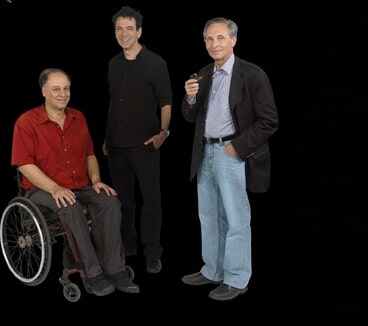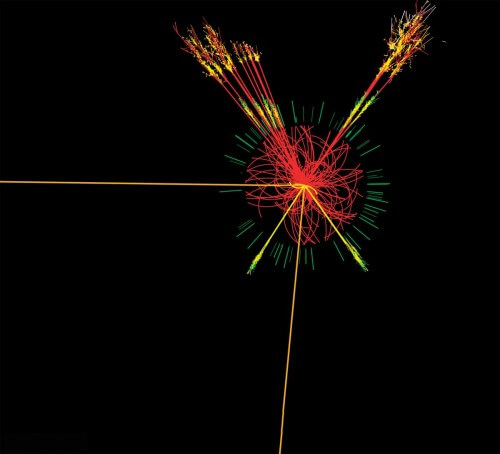The institute's magazine held a celebratory interview with the researchers from the Weizmann Institute who were partners in the discovery of the Higgs

A long and complex journey to discover the "Higgs" particle, which started with one step about 25 years ago, has recently, apparently, reached the goal line. This was reported by the scientists of the LHC particle accelerator at the European Laboratory for the Study of Particle Physics, Saran, near Geneva.
The "Higgs" is the last building block that was missing in the "Standard Model" theory, which describes the structure of matter in the universe. It makes it possible to unite two forces of nature and show that they are, in fact, different aspects of one more fundamental force. In addition, it is responsible for the existence of the elementary particle masses.
The scientists of the Weizmann Institute of Science played a central role in this research journey, throughout its years. For many years, Prof. Giora Mickenberg headed the research group that searched for the "Higgs" in the "Opal" experiment in Saran. He then headed the research group that built the muon detector in the Atlas experiment - one of the two experiments in which the particle was eventually discovered. Prof. Ehud Duchovni leads the group of scientists from the Weizmann Institute of Science, and is currently the head of a research team that examines other central questions in the research. Prof. Elam Gross currently coordinates the physics group searching for Higgs particles in the Atlas experiment. This is also a story about a scientific "grandfather, father and son": Prof. Mickenberg is the teacher of Prof. Duchovny, and both together were the teachers of Prof. Gross. Prof. Vladimir Smakhtin, Dr. Daniel Leloche and Dr. Lauren Levinson worked together with them. The technical team was led by Meir Shua.
Prof. Elam Gross: "This is the greatest day of my life. Since I was a student, in the 80s, I have been searching for the 'Higgs'. It is still hard to believe how 25 years are summed up in a discovery that came surprisingly. It doesn't matter what you call it - from now on we are no longer looking for the 'Higgs' - we are measuring its properties. This is the happiest day of my life - that's what I expected, and I didn't expect that when it happens I will be in such a senior position in the global search team."
For quite a few people, the complex world we live in is a wonderful world. But the physicists among us are not satisfied with the visible reality. They strive to get down to the roots of this reality, and check if it is, really, based on the absolute, lost simplicity of the ancient universe. They strive to see the many particles of matter as "different faces" or as "different compositions" of a few basic particles. They strive to see the four forces acting between these particles (the weak force, responsible for the radioactivity phenomenon; the electromagnetic force; the strong force, responsible for the existence of protons and neutrons; and gravity) as "different aspects" of one and the same basic force of nature (when two particles of matter "give up ” between them in a kind of "ball", we say that a force acts between them, and that the "ball" is a particle that carries this force).
The first step in the journey to unify the forces was completed with the almost certain discovery of the "Higgs" particle - the unification of two forces: the electromagnetic force and the weak force, into a more basic and earlier force, called the electro-weak force. The particle that carries the electromagnetic force is the photon. The weak force is carried by "W" and "Z" particles, which have a precisely measured mass in an experiment in which Weizmann Institute of Science scientists participated. The "W" and "Z" masses are given to them by the "Higgs", named after the Scottish physicist Peter Higgs.
The biggest machine in the world
In an effort to discover the "Higgs", to unite forces and understand the source of mass in the universe, the scientists built the largest machine in the world: a particle accelerator which was built in a circular tunnel that is 27 kilometers long, and it was dug at a depth of about 100 meters below the ground, in the border area between France to Switzerland, at the European Laboratory for the Study of Particle Physics, Sr., near Geneva.
This accelerator, called LHC (short for Large Hadron Collider), accelerates beams of protons to a speed very close to the speed of light (99.999998% of the speed of light), so that, according to the theory of relativity, their mass increases up to 7,500 times their normal mass at rest. He directs the beams against each other, and causes tremendous energy collisions that shatter the particles and create, for the blink of an eye, a very energetic system, similar to the situation that existed in the first fractions of a second after the big bang. As a result, the particles of matter become energy, according to Albert Einstein's famous formula, which describes the equality between matter and energy: E=Mc2. After that, the energy spreads in space and the system cools. As a result, the energy returns and becomes particles of matter, which go through and reproduce the same multi-stage process, until they create the particles capable of existing in the reality we know.
The products of the collisions are energetic particles, some of which exist for very short periods of time (fractions of a second), so that in order to notice their existence one must identify the traces they leave behind. For this purpose, a combination of particle detectors was developed, each of which is adapted to capture certain particles.
statistics
The problem is that the chance of getting the "Higgs" particle in a single collision is equal to the chance of pulling out a single living cell from a certain leaf of a plant growing on the surface of the earth by reaching out a random hand. To deal with this task, Weizmann Institute of Science scientists, led by Prof. Mickenberg, developed unique particle detectors, which were produced at the institute, in Japan and in China. These detectors are adapted to detect muon particles, which are created as a result of the decay of the "Higgs" particle, that is, detections are circumstantial evidence of the previous existence of "Higgs" particles.
The scientists analyzed data obtained from one thousand trillion proton collisions, in which Higgs particles are created, along with many other similar particles. Searching for possible signs of the existence of the "Higgs" is done by finding inconsistencies in the statistical data (compared to the data expected to be obtained if the particle does not exist). This search is focused in the range of the particle's estimated mass: 126 trillion electron volts (GeV). When scientists manage to find such discrepancies, they must rule out the possibility that it is a statistical aberration.
The calculations performed by the scientists in the last few weeks, in which Prof. Gross played a central role, showed with great accuracy that exactly where the "Higgs" particle was expected to be found, a new particle was found, similar in mass to the expected mass of the "Higgs". This careful wording is intended to leave room for the possibility that a new particle other than the "Higgs" will be found precisely in this mass range. The chance of this being the case is, apparently, not great. However, many physicists say that if it turns out that this is really the face of things, then it will be "really interesting".
CERN

Saran scientists made a major contribution to the development of computer languages and the basic concepts that later served as a basis for the establishment of the Internet. In fact, the first server of the "Worldwide Web Network" was activated in Saran in order to create good communication between scientists from all over the world who participate in the experiments being carried out there. The organization also served as a model for the establishment of the European Union, and its influence on technology and the economy is somewhat reminiscent of the American space program.
The LHC accelerator is based on superconducting electromagnets, which operate at very low temperatures: less than two degrees above absolute zero (minus 271 degrees Celsius), and it produces about a billion particle collisions per second. The need to calculate and analyze the information from all these collisions is equivalent to trying to understand what all the inhabitants of the world are saying, when each of them is conducting 20 phone calls at the same time.
This experimental system includes the largest superconducting electromagnets in the world, built with the participation of Israeli companies.
The entire structure includes 10,000 radiation detectors, located with an accuracy of one millimeter in a space that has a volume of 25,000 cubic meters, and includes one and a half million electronic channels. Most of the muon detectors in this large mechanical structure are built from components manufactured in Israel. A unique laser system tracks the exact position of the detectors, with an accuracy of 25 microns (half the thickness of a human hair).

4 תגובות
oak
Too bad about the tuition. The Higgs mass is a data external to the theory, an external parameter. as speed
The light or the electron charge are externally measured quantities and are not obtained from any theory, so is the Higgs mass.
The difficult question is why the masses of the other particles are not external parameters in the theory and why
Need the Higgs to give them mass. The answer to this question is more complex, but on one foot, it is not allowed
For reasons of symmetry determine a mass for the particles of matter, meaning the theory predicts that they will be massless
Like the photon, to explain why they still have mass, a Higgs mechanism was proposed.
oak
You will learn quantum physics, and you will find out 🙂 . (Of course, for this you will need a bachelor's degree in physics, but this is also not a reason for the problem since this can also be studied and obtained). Successfully.
I do not understand,
If the Higgs is what gives matter its mass, how exactly do you find its own mass?
"And I didn't think that when it happened I would be in such a senior position in the global search team"